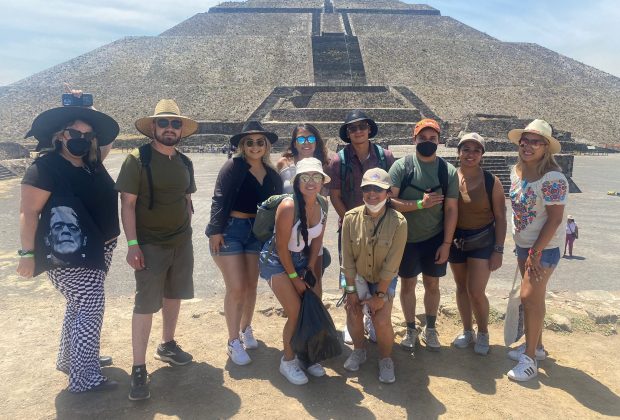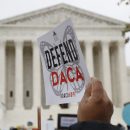|
WELCOME HOME SUMMER '22 STUDY ABROAD GROUP 1 AND CONGRATS ON A SUCCESSFUL JOURNEY!
|
|
|
|
Throughout this week's newsletter, we will be featuring photos from Group 1's successful journey to Mexico and back to the U.S. on Sunday, June 12, 2022.
|
|
|
By Miriam Jordan | The New York Times | JUN. 15, 2022 | Photo by Jenna Schoenefeld
|
|
LOS ANGELES — Tommy Esquivel graduated from Hollywood High School in Southern California last week with awards honoring his determination, his record of service and the highest average grade in his Advanced Placement environmental science class. “I am excited to see what you will do with your future,” his science teacher, Alycia Escobedo, said in a farewell note. “Do big things.”
But Mr. Esquivel, 19, who grew up in Los Angeles without legal immigration status, faces significant obstacles to realizing his potential. He has limited access to financial aid for college. In many states, he cannot obtain a driver’s license. Without a Social Security number, he cannot legally work. And though he has lived in the United States since the age of 9, he could at any time face deportation to Guatemala.
For the first time, a majority of the undocumented immigrants graduating from high schools across the United States have none of the protections offered over the past 10 years under an Obama-era program that shielded most of the so-called Dreamers from deportation and offered them access to jobs and help with college tuition... READ MORE
|
|
|
By Rafael Bernal | The Hill | JUN. 14, 2022 | Photo by Camille Fine
|
|
The Deferred Action for Childhood Arrivals program turns 10 years old Wednesday, beset by lingering doubts about both its future and the current protections it grants to young immigrants.
The program, known widely as DACA, was instituted in a moment of crisis after then-President Obama hit a brick wall in his legislative attempts to modernize the immigration system.
For around 800,000 so-called Dreamers, undocumented immigrants who arrived in the country as minors, DACA made possible a close-to-normal American life with access to work, education and basic government services and reduced risk of deportation.
But a decade in, DACA is endangered by court actions and political sclerosis, putting its remaining 611,000 beneficiaries at risk of falling back into undocumented status.
“DACA has always been temporary. And because of the temporary nature of the program, the reality is that it’s just not enough. It is simply not enough to provide the long-lasting relief that folks need,” said José Muñoz, a DACA beneficiary and deputy communications director at United We Dream, an immigrant youth advocacy organization... READ MORE |
|
|
By Angelika Albaladejo | Capital and Main | JUN. 15, 2022 | Photo by Chip Somodevilla
|
|
Immigrant youth activist Juliana Macedo do Nascimento on the good and bad about DACA.
What was introduced 10 years ago as a stopgap to protect immigrant youth has endured in the face of legal attacks and congressional failures to pass a more permanent solution. Deferred Action for Childhood Arrivals, better known as DACA, is simultaneously recognized by immigrant-rights advocates as the most consequential policy change in decades and as an impermanent change that has left hundreds of thousands in legal limbo.
To understand what DACA has accomplished and where it has fallen short, Capital & Main spoke with Juliana Macedo do Nascimento, who directs federal advocacy for the nation’s largest immigrant youth-led grassroots network, United We Dream. Nascimento was born in Natal, Brazil, and moved to the United States at age 14 with her family. She grew up undocumented in California and is herself a DACA recipient.stone of the summit. Diaz just wishes she had more of a say... READ MORE
|
|
|
By Cindy Carcamo, Andrea Castillo, Jeong Park | Los Angeles Times | JUN. 15, 2022
Photo by Francine Orr
|
|
At 13, Reyna received her first planner. Since then, she’s rigorously scheduled nearly every day of her life: showers, meals, study time, university applications. If she planned carefully, she believed, she’d go to college and someday become a civil rights attorney.
But Reyna, who was 2 when her mother carried her across the border from Mexico for the United States in 2006, is in the country without legal status. Perhaps most importantly, she was cut off from Deferred Action for Childhood arrivals — better known as DACA — an Obama-era policy that gave certain immigrant youths a work permit and protection from deportation.
There are 611,470 DACA recipients, according to USCIS data from Dec. 31, 2021, and more than 800,000 people have been enrolled since its inception. To qualify, so-called Dreamers had to have been in the U.S. since 2007, have arrived before turning 16, and be under age 31 as of 2012. They also needed to meet certain educational and criminal history requirements.
As DACA turns 10 today, it’s bittersweet for Reyna, who graduated high school in Los Angeles this year along with an estimated 100,000 other immigrant youths without legal status and without the benefit of DACA, according to a study released in May.
They are coming of age without the benefits and protections that their older peers enjoy, because they were too young to qualify for the program before the Trump administration moved to end it five years ago and a court ruling limited the government to process DACA renewals, not new applications. In July, the 5th Circuit Court of Appeals is set to hear oral arguments in the case — which is likely to reach the Supreme Court — that will decide whether such an expansive program is lawful... READ MORE
|
|

|
|
Mictlan Restaurant at Teotihuacan. Dinner and Aztec Dance performance.
|
|
|
By Andrew Selee | Migration Policy Institute | JUNE 2022 | Photo by Freddie Everett
|
|
The Los Angeles Declaration on Migration and Protection signed by leaders from countries across the Western Hemisphere at the conclusion of this week’s Summit of the Americas commits their governments to expand legal migration pathways, support immigrant integration, invest in migration management, and coordinate responses to mass migration movements and displacement crises. While the agreement is nonbinding, it marks a significant step forward in creating a common language and a coherent set of ideas for more cooperatively managing migration movements across the Americas, a region that has seen very significant mobility in recent years.
Latin American and Caribbean countries have a long history of cooperation around migration and protection. This history includes several mobility agreements that allow people to move within specific subregions (including Mercosur, the Andean Community, CARICOM, and a group of Central America countries). There have also been attempts to synchronize humanitarian protection policies both through the Cartagena Declaration in 1984 and, most recently, the Quito Process, which has helped governments coordinate their response to the Venezuelan displacement crisis. However, none of these agreements have involved such a hemispheric-wide group of countries as the Los Angeles Declaration does and, perhaps even more importantly, none have as directly involved the United States and Canada until now... READ MORE
|
|
|
By Lauren Feiner | CNBC | JUN. 7, 2022
|
|
Amazon, Google, Salesforce and Uber are urging the Department of Homeland Security to revise its aging out policies for children of high-skilled visa holders.
A coalition of tech companies including Amazon, Google, Salesforce and Uberare urging the Department of Homeland Security to revise policies for children of high-skilled visa holders, many of whom work for their businesses, so they can stay past the age of 21 without a green card.
In a letter to DHS Sec. Alejandro Mayorkas made public on Tuesday, the companies asked that the Biden administration “establish more robust aging out policies.” They point to the more than 200,000 children who have grown up in the U.S. while their parents held visas, including the high-skilled H1-B visa that’s particularly common in the tech industry. Once those children turn 21, they must apply for a green card, a process that can drag on and even force some to leave in the interim... READ MORE
|
|

|
|
Study Abroad Group 1 in front of the UNAM Museum of Contemporary Art.
|
|
|
Column by Jean Guerrero | Los Angeles Times | JUN. 9, 2022 | Photo by Moises Castillo
|
|
President Biden wants to slow migration to this country, a priority of his administration at the Summit of the Americas. It’s a bizarre venue to make such a stand, considering that the event is happening in Los Angeles, a crossroads of the Latino world.
The summit became a snub to Latinos the moment Biden prioritized Florida’s conservative Cuban Americans above other Latinos, such as Mexican Americans. This was the rationale behind barring Cuba, along with its perceived allies Nicaragua and Venezuela. The exclusion defied leaders such as Mexico’s President Andrés Manuel López Obrador, who decided to boycott this week’s event.
The gathering could have elevated the Latin American diaspora, who understand immigration’s root causes better than anyone. Instead, the immigrants working the summit, busing dignitaries’ tables and making their hotel beds, feel unheard.
Biden has used the summit to inhabit a self-defeating archetype: the compassionate nativist, as former President Obama did when quoting Scripture’s advice against oppressing the stranger even while setting records for deportations.
The compassionate nativist takes pains to distinguish himself from the sadistic one. He won’t insult the stranger. He’ll tell her not to come, sure, but he won’t call her names. He’ll stifle her movement by militarizing borders, but he’ll also boast of “aid” and private investments to address immigration’s supposed “root causes.”
He’s hypocritical and blind to history, which shows that investments in export-oriented industries, including some of those that Vice President Kamala Harris is encouraging in Central America, are primary drivers of displacement for Black and Indigenous people — concentrating wealth among local elites and foreign investors. Like the sadistic nativist, the compassionate one fails to slow immigration... READ MORE
|
|
|
Excerpt and Book cover by Ran Abramitzky and Leah Boustan | TIME | JUN. 1, 2022
|
|
In April 2020, the New York Times ran a special feature called “I Am the Portrait of Downward Mobility.” “It used to be a given that each American generation would do better than the last,” the piece began, “but social mobility has been slowing over time.”
In paging through the profiles, we couldn’t help noticing one group of Americans who defies this trend: the children of immigrants. Sonya Poe was born in a suburb of Dallas, Texas to parents who immigrated from Mexico. “My dad worked for a hotel,” Sonya recalled. “Their goal for us was always: Go to school, go to college, so that you can get a job that doesn’t require you to work late at night, so that you can choose what you get to do and take care of your family. We’re fortunate to be able to do that.”
The dream that propels many immigrants to America’s shores is the possibility of offering a better future for their children. Using millions of records of immigrant families from 1880 to 1940 and then again from 1980 to today, we find that the in past and still today children of immigrants surpass their parents and move up the economic ladder. If this is the American Dream, then immigrants achieve it—big time.
One pattern that is particularly striking in the data is that the children of immigrants raised in households earning below the median income make substantial progress by the time they reach adulthood, both for the Ellis Island generation a century ago and for immigrants today. The children of first-generation immigrants growing up close to the bottom of the income distribution (say, at the 25th percentile) are more likely to reach the middle of the income distribution than are children of similarly poor U.S.-born parents.
What’s more, no matter which country their parents came from, children of immigrants are more likely than the children of the U.S.-born to surpass their parents’ incomes when they are adults. This pattern holds both in the past and today, despite major changes in U.S. immigration policy over the past century, from a regime of nearly open borders for European immigrants in 1900 to one of substantial restrictions in recent decades. Children of immigrants from Mexico and the Dominican Republic today are just as likely to move up from their parents’ circumstances as were children of poor Swedes and Finns a hundred years ago.
Not only does upward mobility define the horizons of people’s lives, but it also has implications for the economy as a whole. Even immigrants who come to the U.S. with few resources or skills bring an asset that is hugely beneficial to the U.S. economy: their children. The rapid success of immigrants’ children more than pays for the debts of their parents... READ MORE
|
|

|
|
Group 1 visits UNAM Biodiversity Museum.
|
|
|
By Christopher Knight | Los Angeles Times | JUN. 13, 2022
Photo by Tatiana Mata
|
|
The other day, I drove over to Cal State Long Beach and saw an exhibition of Carolyn Campagna Kleefeld’s paintings and drawings from the last 30 years, which are on view inside the Carolyn Campagna Kleefeld Gallery at the newly expanded and renamed Carolyn Campagna Kleefeld Contemporary Art Museum.
If you think this nesting doll of names is odd, even in our era of bloated naming opportunities at cultural institutions, you would be right. I’ve never seen anything quite like it. In Los Angeles, every third arts building seems to be named Geffen or Broad, while in San Diego it’s the Jacobs moniker that’s over many a front door. Fine. Rarely, however, do big, raised letters of a naming opportunity inside a museum room identify the same donor whose name is also in big, raised letters on the edifice outside. Virtually never is the art on view made by the same-named patron.
Welcome to Long Beach. Here at Cal State University, Kleefelds in the Kleefeld at the Kleefeld are the new norm. Disturbingly so. It’s a train wreck, and a serious disservice is being done to students.
The show, which features 10 canvases and 13 works on paper, is a small selection from a gift that the artist made to the museum, including 74 of her paintings and 104 of her drawings. Kleefeld art is now about 6% of the museum’s permanent collection. (I’m unaware of its presence in any other museum’s collection.) Her own art will rotate in her dedicated gallery. Also donated were her library, a personal archive and copies of more than 20 inspirational books she has written.
Did I mention the $10-million check? That came too.
Cal State Long Beach raised $24 million to expand and refurbish the former University Art Museum, in operation since 1973, by 4,000 square feet. (It reopened in February... READ MORE
|
|
|
By Fidel Martinez | Los Angeles Times | JUN. 9, 2022
|
|
“Bad Mexicans: Race, Empire, and Revolution in the Borderlands,” the latest book by historian Kelly Lytle Hernández, starts off with the lynching of Antonio Rodríguez in Rocksprings, Texas.
The 20-year-old Mexican ranch hand was taken by a mob and burned alive on Nov. 4, 1910. The extrajudicial murder was by no means an isolated incident — there is a long history of Mexicans and Mexican Americans being lynched at the border — though it did prove to be particularly consequential. His death led to anti-American protests in Mexico, where there was growing consensus that the dictatorship of Porfirio Díaz had placed the interests of American capitalists above its own citizens.
Weeks later, on Nov. 20, 1910, the Mexican Revolution began.
The lynching of Rodríguez isn’t some new historical discovery. As Lytle Hernández — a professor of history, African American studies and urban planning at UCLA, and a 2019 recipient of the MacArthur Fellowship (the so-called “genius grant”) — explained to me, “many Mexican scholars who’ve written about the Mexican Revolution acknowledge the murder of Antonio Rodríguez as a precursor to the revolution.”
“The only thing I’m doing with this book is taking everything and pivoting and positioning it within the context of U.S. history.”
That’s the central premise of “Bad Mexicans,” the idea that Mexican and U.S. histories aren’t isolated from each other but are so intertwined that you can’t separate them. Rodríguez’s lynching is just one of many examples that prove her thesis. The book itself focuses on the magonistas, a group of anarchist and socialist dissidents led by the Flores Magón brothers, who fled Mexico and came to the United States to successfully incite a revolution against the Porfiriato via their outlaw newspaper, Regeneración. Much of this story takes place in cities I’m familiar with — Laredo, San Antonio and Los Angeles, to name a few — but knew very little about... READ MORE
|
|
|
CENTRO CHA COMMUNITY UPDATE
|
|
|
Please consider sponsoring our program today!!!
To be a sponsor contact Professor Armando Vazquez-Ramos at: armando@calmexcenter.org or 562-972-0986
|
|
|
|
|




























